A Light Hand Is Key When Making Cornbread Croutons
Whether or not you subscribe to the belief that a salad is actually a vessel for croutons, it's hard to argue with the effect some small pieces of bread can have on a pile of lettuce. They bring a crunch that iceberg, cucumber, and even carrots can't compete with, and add flavor that celery wishes it could offer. Not to mention, croutons are the perfect thing to snack on through your salad-making process — just save a few for your final dish, okay?
Any kind of bread can be a crouton: Hand-torn chunks of sourdough, nutty pumpernickel, crispy-salty wedges of pita, or — one of our favorites — sweet, slightly crumbly cubes of cornbread. Pair them with chipotle ranch for a Southern twist on a classic Cobb, sprinkle a few on your next bowl of three-bean chili, or swap cornbread croutons for the packaged variety for a harvest-inspired cornbread stuffing next Thanksgiving. They're flavorful and easy to make — as long as you're gentle.
Why do you need to have a light hand when making cornbread croutons? Cornbread is notoriously crumbly (though you can play with your fats and types of cornmeal to tweak the texture). After you've sliced it into cubes, you still need to add oil and seasonings, and if you're not careful, you'll wind up with a bowl full of flavorful crumbs instead of the bite-sized pieces you were hoping for. But have no fear. With a few easy tips, you'll be enjoying perfect cornbread croutons in a Jiffy.
Here's why day-old cornbread is your friend
The key to successful homemade cornbread croutons is starting with bread that is structurally sound. The goal with fresh cornbread is usually something soft and tender — which won't hold up to even gentle tossing with oil and seasonings. But there's an easy solution: Wait a day, allowing your bread to get a little bit stale, before making croutons.
Stale bread is both dryer and more tough than fresh bread. By letting the cornbread get just a bit stale, it becomes more sturdy. This change in texture will allow you to dice your cornbread, as well as gently toss it in oil and seasonings, without it completely disintegrating in your fingers. You'll still need to be more careful than if you were using a cubed baguette for your croutons. Use your hands instead of a spatula or tongs so you can handle the cornbread delicately.
Once the cubes of cornbread are seasoned, spread them onto a baking sheet with space between the pieces. Put them in a warm oven (350 to 375 degrees Fahrenheit) and use that heat to toast and dry the bread. Once your croutons are golden brown, give them time to cool so they get extra crunchy.
How to make croutons from fresh cornbread
Are you craving croutons but find yourself all out of cornbread? You don't have to wait until tomorrow to enjoy this crispy, crunchy topping — but you will need to have some patience. When making homemade cornbread specifically for croutons, trade out your cast iron skillet or cake pan for a rimmed sheet pan. By baking your bread on a thin sheet, your bread will bake faster and be dryer, without a tender center. It will also be a better thickness for crouton-making, meaning you can simply slice it into squares instead of having to cut each thicker piece crosswise to get bite-sized pieces. Be sure to line the pan with parchment paper for easy removal.
After baking, be sure to let it cool completely before slicing. A warm slice of cornbread is perfect for slathering with butter and honey, but isn't stable enough to be cubed and tossed with seasonings.
One other benefit to making fresh cornbread is flavor. Add seasonings to the batter — or use Nancy Silverton's creamed corn trick — to give your croutons a major boost with less tossing later.
Of course, if your cornbread is fresh, it will be more delicate than bread that has started to get stale. To avoid over-agitating the croutons, do your seasoning on a sheet pan. This will allow you to more evenly distribute your fat and seasonings so you don't have to mix so much, lowering the chance of reducing your cornbread to rubble.


